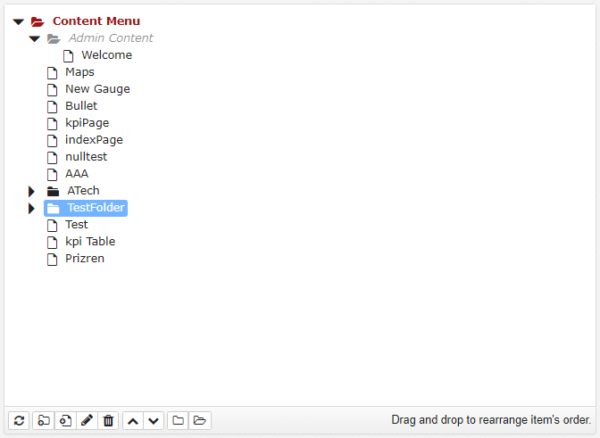Pages are stored in the system using a hierarchical structure. The structure is presented as a tree in the Manage Pages user interface.

★ Note: Access the Manage Pages dialog using the icon in the Admin Toolbar, the vertical toolbar on the left side of the screen.
Actions
The following actions can be performed from the “Manage Pages” dialog.
| Icon | Action | Description |
|---|---|---|
| Refresh | Reload the content. | |
| Add Folder | Creates a new folder in the system. The new folder will be created as a child element of what is selected in the content tree. | |
| Add Page | Adds a new page to the system. The new page will be created as a child element of what is selected in the content tree. | |
| Edit | Launches a dialog, allowing administrators to edit the properties of the selected page or folder. | |
| Remove Page | Deletes the selected page or folder from the system. | |
| Move Up | Moves the selected page or folder up in relation to its siblings. This will affect the order of pages in the banner. | |
| Move Down | Moves the selected page or folder down in relation to its siblings. This will affect the order of pages in the banner. | |
| Close All Folders | Close all folders in the “Content Menu” tree. | |
| Open All Folders | Open all folders in the “Content Menu” tree. |
Editing a Page
Editing a page exposes where the pages reside on the system, as well as how it is presented within the navigation system.
It is important to note that the folder system used here has implications when provisioning content. If groups of users can be granted access to groups of content, it makes the provisioning process a lot easier. As such, the structure used for organizing content should reflect how different groups will access the content.

Page Name
The page name is what will appear in the navigation menu.
Menu Visibility
This property determines whether a page (or folder) is directly accessible through the navigation menu. The navigation menu is represented by tabs in the banner of the user interface. If a page is hidden, then it will not appear as a tab.
- Show in Menu – The folder or page will appear in the navigation menu. It will be directly accessible via a tab, as well as via a “Switch to Page” action.
- Hide from Menu – The folder or page will be hidden in the navigation menu. The only way to access a hidden page is through a “Switch to Page” action.
Page Location
This represents where a page physically resides on the system. This physical location has two separate implications.
- The order in which the pages appear in this tree will be the order in which they are displayed as menu items.
- The folder structure can affect which users can access the page.
Moving Pages and Folders
When moving a page or folder from one folder to another, the system will prompt for confirmation about whether it should move associated provisioning configuration. Note that the provisioning configuration that is affected is only that relating to the specific item (page or folder) being moved, and in the case of a folder, also any children of that folder. So a page or a folder that is not explicitly provisioned to a domain, but is implicitly provisioned due to an ancestor folder being provisioned, may end up being not provisioned, if it is moved to a folder that is not already provisioned.

- Yes – Existing provisioning will be kept, and the page will remain accessible by anyone who could access it before.
- No – Existing provisioning information will be lost, and the page will inherit new permissions based on its new location.